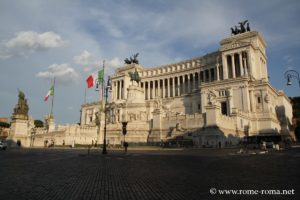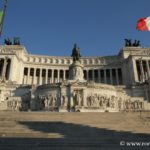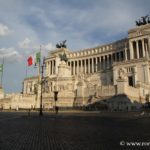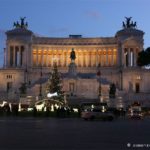Name in Italian: Monumento a Vittorio Emanuele II
In Rome, one inevitably passes by this gigantic white marble structure, the Victor Emmanuel II Monument , also known as the Altar of the Fatherland and nicknamed the Vittoriano. Its imposing mass is far from unanimously appreciated among Romans, who commonly refer to it as the “scrivania,” or typewriter.
Nevertheless, it remains an unmissable neoclassical masterpiece of the Eternal City.
Visiting the Monument to Victor Emmanuel II ranks number 27 in our Top 30 Things to See in Rome.
Overview and Visit to the Vittoriano
Built between 1885 and 1927, the Vittoriano celebrates the unification of Italy under the reign of Victor Emmanuel II, the first king of a newly unified Italy. Situated against the Capitoline Hill near Piazza Venezia, this white marble monument draws inspiration from the Pergamon Altar, a Hellenistic structure from the 2nd century BC. Its neoclassical architecture, designed by Giuseppe Sacconi, impresses with its scale and symbolism.
The monument’s steps lead to a vast platform housing the Tomb of the Unknown Soldier, a tribute to soldiers who fell during World War I and were never identified or buried. Above it, a statue of the goddess Roma stands at the center, surrounded by bas-reliefs inspired by Virgil’s Bucolics and Georgics. Higher up, the 12-meter-tall gilded bronze equestrian statue of Victor Emmanuel II dominates the structure, set before a grand portico with imposing columns. At its base, allegories represent Italy’s 14 noble cities. Finally, the lateral Propylaea feature two bronze quadrigas: the Unity of the Fatherland (Carlo Fontana) on the left and Liberty (Paolo Bartolini) on the right.
Inside, the Central Museum of the Risorgimento traces the history of Italian unification, while temporary exhibitions occupy adjacent rooms.
Photo Gallery of the Monument to Victor Emmanuel II
- Vittoriano
- Victor Emmanuel II Monument
- Victor Emmanuel II Monument
- Piazza Venezia
- Piazza Venezia
Practical Information and Location
- Open Monday to Sunday from 9:30 AM to 7:30 PM, with last entry at 6:45 PM
- The changing of the guard at the Tomb of the Unknown Soldier takes place hourly
- Closed on December 25 and January 1
- Free entry to parts of the site
- Paid access to the panoramic terrace:
€15 for full price + possible exhibition fee, with a guided route. €2 for ages 18-25, free for under 18.
Ticket valid for 7 days.
The ticket also includes entry to the Central Museum of the Risorgimento and the National Museum of the Palazzo Venezia
Sources and Useful Resources
Map and Location
The Vittoriano is located at Piazza Venezia, a central square in Rome served by numerous bus lines. The nearest metro station is Colosseo (Line B), a 10-minute walk away.
If you see this after your page is loaded completely, leafletJS files are missing.
FAQ and Visiting Tips
What to See at the Monument to Victor Emmanuel II?
- Equestrian Statue of Victor Emmanuel II
This 12-meter-tall gilded bronze statue, in a commanding position, represents the first king of unified Italy, surrounded by sculptures of 14 historic noble cities. - Tomb of the Unknown Soldier
Located beneath the statue of the goddess Roma at the base of the monument, it honors unidentified World War I soldiers with two eternal flames and an honor guard. - Panoramic Terrace and Quadrigas
Accessible by elevator, it offers a 360° view of Rome near the two bronze quadrigas. - If you’re interested in history: Museum of the Risorgimento, located inside the monument, accessible via the entrance at Via di San Pietro in Carcere. It covers the history of Italian unification from the 18th century to World War I.
How Long Does It Take to Visit the Vittoriano?
Recommended duration: About 2 hours to see the highlights (exterior and terrace).
Why Do Romans Call the Vittoriano “the Typewriter”?
Romans nickname the monument “scrivania” (typewriter) due to its rectangular shape and aligned columns, reminiscent of an old typewriter. The nickname also reflects criticism of its massive, ostentatious style.













